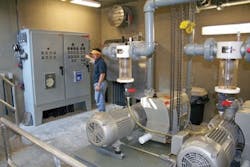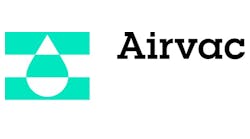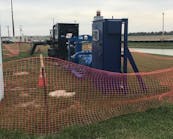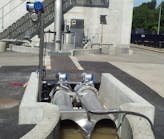Airvac
undefinedVacuum technology saves time and money, and meets town’s goal of environmental stewardshipNo two public works projects are alike. However, there are certain profiles that are repeated, especially in similar geographic areas.
Oceanside communities with flat topography, sandy soil and high groundwater are a recurring scene along the coast in North Carolina. These conditions present significant problems when designing wastewater collection systems. Gravity systems, in these circumstances, are especially difficult to install because of the issues associated with deep trenching and dewatering. The water table in many seaside areas is only 3 or 4 ft below grade. Installing large gravity-flow lines may require trenches that are 15 ft deep. It is a costly, dangerous and disruptive combination of factors.
Experience shows that vacuum sewer technology is an excellent alternative to gravity systems in these conditions. The characteristics of vacuum technology eliminate many of the issues that make the installation of gravity sewers expensive and disruptive in these seaside communities. For a variety of reasons, vacuum sewer technologies such as AirVac are now recommended for projects like the one recently completed in Holden Beach, N.C.
Holden Beach is located on one of the barrier islands along the Atlantic coast. It has all of the geographic characteristics that are often seen in this region—sandy soil, high groundwater and flat terrain. The community is primarily a resort location populated with vacation homes and rental properties. Real estate values are very high and available space is at a premium.
One can usually point to five specific areas where vacuum technology is superior to gravity systems.
Installation Ease
In flat topography with high groundwater, vacuum sewers are much easier and faster to install than gravity sewers. For instance, vacuum collection lines are often smaller than gravity lines. They are typically about 4, 6, 8 and 10 in. in diameter and made of SDR 21 or Schedule 40 PVC pipes. These small, lightweight pipes can be installed with small equipment. Because of the sawtooth profile, the lines can be buried in shallower trenches, typically 4 to 6 ft deep. This typically means less digging, less dewatering and fewer construction-related restoration issues.
Installation progress can be much faster, too. In Holden Beach the installation crews estimated that they were laying up to 200 ln ft per day. A gravity sanitary sewer installation would have probably accomplished less than 100 ln ft per day because of localized conditions.
Perhaps even more important, the design called for only four vacuum stations to serve approximately 3,000 connections. Had there been a gravity system installed, the team would have needed about 15 pumping stations. Considering the property values in Holden Beach, this was an important cost-saving factor. It was also a quality of life factor that was valued by the town.
Operations and Maintenance
Vacuum systems are very easy to maintain. Most vacuum system functions can be monitored at the vacuum stations. If there is ever a loss of vacuum pressure in the collection lines, the problem can be isolated quickly and repaired easily. The lines are typically only 4 to 6 ft deep, so excavation is not difficult. Vacuum lines require no cleaning, as the velocity of the flow in the pipes scours the lines and helps prevent buildups and clogs. And, because vacuum sewers are closed systems (no infiltration or exfiltration), they are not required to have periodic TV inspections as is common with gravity sewers. Operations and maintenance personnel also appreciate the fact that they seldom, if ever, come in contact with raw sewage.
In the case of Holden Beach, AirVac provided training and brought in field service technicians to answer questions and provide advice. They also conducted plumber workshops advising local plumbers on the correct way to connect a residence to the AirVac system.
Like most communities along the Atlantic coast, Holden Beach is subject to hurricanes and storm damage. When electrical power is lost or when there is a storm surge, a conventional gravity sanitary sewer is often knocked out of commission, leading to sanitary sewer overflows. A vacuum system, on the other hand, can be designed and operated to lessen the calamity of a tropical event.
In the case of Holden Beach, the four vacuum stations are built below grade in watertight vaults. Not only is this an aesthetic benefit (no vacuum stations to block the beautiful sea views), it also protects the system from storm surges. And because it is a closed system, storm water and sand cannot infiltrate and clog the lines or overwhelm the treatment facility. With regard to electrical power, the individual valve pits that connect the homes to the system operate by pneumatic pressure—no electricity is required, and the team can keep the vacuum stations operational by utilizing portable generators.
Green Issues
One of the factors that led Holden Beach to examine a new sewage collection system were the problems associated with septic tanks and failing drain fields. Regardless of the sewer technology selected, the town saw removing the onsite systems as a step toward a cleaner environment.
The new vacuum sewer system in Holden Beach supports the town’s goal of environmental stewardship by providing a closed system that is much less prone to sanitary sewer overflows when compared to a conventional gravity sanitary system. In particular, the elimination of infiltration and inflow makes vacuum sewer technology attractive to coastal communities.
Vacuum technology has proven effective for conditions like those in Holden Beach. It saves time, money and provides an effective sewer collection process that is easy to maintain and durable to boot.



